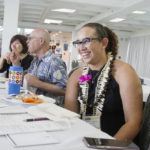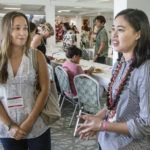It was almost like show-and-tell Thursday at Grand Naniloa Hotel.
There, 16 of the Akamai Workforce Initiative’s 38 summer interns made presentations about their summer work during one of four symposiums that conclude the program. Projects varied across multiple disciplines, but the passion and knowledge was evident with each speaker.
The Akamai Workforce Initiative is a program that aims to advance Hawaii college students into science and technology careers.
With lead funding from the Thirty Meter Telescope, the program offers community college and undergraduate students the opportunity to complete projects at observatories and high-tech companies in Hawaii. Students are from Hawaii or enrolled at a University of Hawaii campus.
Maria Daniella Douglas was one intern who addressed the crowd. In simple terms, she spent her summer working to determine whether certain asteroids in a near-Earth orbit were related to a family of asteroids in the main asteroid belt, located between Mars and Jupiter.
“For me, it’s just very interesting that we can take something near Earth and trace its history back to the main belt,” she said, adding that that knowledge is important for understanding “how things work in our solar system,” and how things can move from the main asteroid belt.
Douglas, who is originally from the Philippines but grew up in San Francisco, is studying astronomy at the University of Hawaii at Manoa, where she will be a senior.
She worked at UH-Hilo this summer with mentor and Akamai alum Heather Kaluna, an associate professor in the Department of Physics and Astronomy.
“It was really amazing,” Douglas said of the internship experience. “So I’m an astronomy student. We do a lot of theory and learning in class, but this was actually like my first real application of what I’ve been learning in class.”
It was “definitely cool” to see what was learned in class finally put to use, she said.
The summer also was a chance to scope out future career fields.
While Douglas said she’s not quite sure what she wants to do yet, graduate school is an option. But the summer has “definitely molded what I think of astronomy jobs. I also learned about outreach jobs this summer, and now I know what research is like and what outreach can be like.”
Kaluna, who went through the Akamai program in 2007, echoed those sentiments. The benefits of her experience was “getting a real taste for research and getting a sense of, ‘Is this really what I want to do for a career?’” she said. “Because when you’re going through your studies and classes and stuff, you’re learning a lot of the theoretical sides of things.”
Being able to put that to use is a “really good way to just help figure what you want to do,” Kaluna continued. “That was the huge thing for me.”
Kaluna was a mentor for the first time this year, which she said was an “amazing experience.”
“One of the things this program tries to do, is they take information from the students — their interest, backgrounds, and they try to pair them with the most appropriate mentor,” she explained.
That leads to productivity.
The results she and Douglas got are “very exciting … something we’re going to publish together,” Kaluna said. “… This is actually a nice product coming out of it. So it’s really nice to be able to give that opportunity to a student who’s still at the undergraduate level because if she does choose to get into a graduate program, she’ll be so much more prepared having this kind of experience under her belt.”
Intern and Hilo native Makena Wagner is heading into her junior year at Smith College in Massachusetts, where she studies engineering.
She spent the summer interning at Gemini Observatory, where she worked to create testing rigs to determine whether replacement linear encoders will work as intended without having to install them on the telescope.
Wagner also was thankful for the work experience provided by the internship.
“Working for Gemini, I learned how to do basically all the steps it takes to actually design something and then actually have a part in front of you that you made from scratch,” she said. “I think that was the highlight of my internship — actually going through all of these precise steps, doing all these calculations and finally seeing the end product, because that’s how it is when you design something for an observatory or in the workforce. Those are the steps you need to take.”
And while the work experience is important so students can see what field they like, there are other benefits, too.
“I feel like Akamai is a really good opportunity for college students to really get to know your community and make connections and grow your network,” Wagner said, the importance of which isn’t always recognized by new college students.
Wagner said she loved working at Gemini, but next summer she hopes to find another internship that will allow for more field work.
Akamai is led by the Institute for Scientists and Engineering Educators at the University of California, Santa Cruz.
ISEE Director Lisa Hunter said there’s a need for a local workforce, and local students who are interested in staying in the state and working a scientific or technology-related job.
“So the program really is aimed at matching that up, providing that connection between local workforce needs and students (who wish to) move into technical jobs,” she said following the completion of student presentations.
Now wrapping up its 16th year, Hunter said nearly 400 students have gone through the program.
According to Hunter, only about 40 percent of students who start off and are interested in a STEM (science, technology, engineering and mathematics) degree, graduate with degrees in those areas. But of those who go through the Akamai program, 87 percent stay in a STEM field.
“The program really focuses on giving students an authentic experience in a technology workplace, and we work with mentors on how to create, how to provide an authentic experience, and the students really rise to that,” she said.
“They’re challenged, but they come up, achieve the challenge, and they learn how to interact in the work environment. They learn how to talk like an engineer and work like an engineer. Those are the things I think that have really made the program work.”
Email Stephanie Salmons at ssalmons@hawaiitribune-herald.com.



